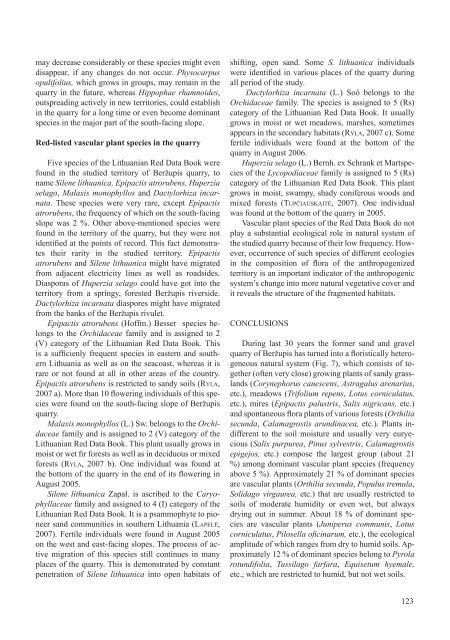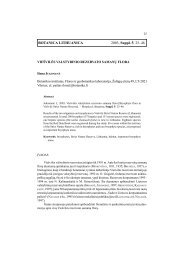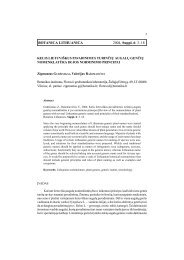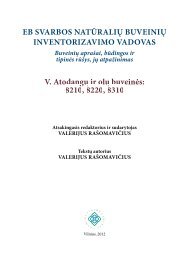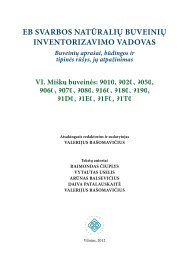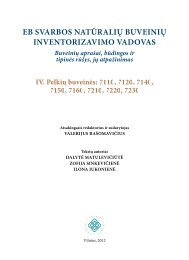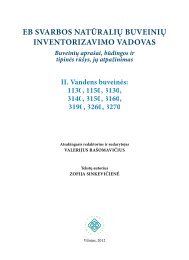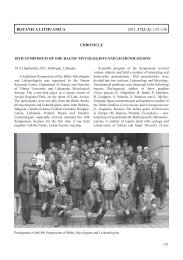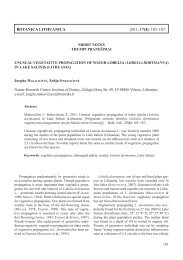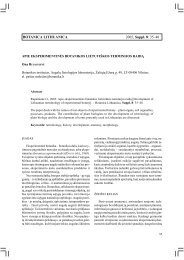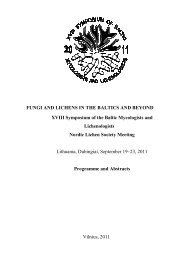Botanica Lithuanica 2011, 17(2–3): 117–125
Botanica Lithuanica 2011, 17(2–3): 117–125
Botanica Lithuanica 2011, 17(2–3): 117–125
Create successful ePaper yourself
Turn your PDF publications into a flip-book with our unique Google optimized e-Paper software.
may decrease considerably or these species might evendisappear, if any changes do not occur. Physocarpusopulifolius, which grows in groups, may remain in thequarry in the future, whereas Hippophae rhamnoides,outspreading actively in new territories, could establishin the quarry for a long time or even become dominantspecies in the major part of the south-facing slope.Red-listed vascular plant species in the quarryFive species of the Lithuanian Red Data Book werefound in the studied territory of Beržupis quarry, toname Silene lithuanica, Epipactis atrorubens, Huperziaselago, Malaxis monophyllos and Dactylorhiza incarnata.These species were very rare, except Epipactisatrorubens, the frequency of which on the south-facingslope was 2 %. Other above-mentioned species werefound in the territory of the quarry, but they were notidentified at the points of record. This fact demonstratestheir rarity in the studied territory. Epipactisatrorubens and Silene lithuanica might have migratedfrom adjacent electricity lines as well as roadsides.Diasporas of Huperzia selago could have got into theterritory from a springy, forested Beržupis riverside.Dactylorhiza incarnata diaspores might have migratedfrom the banks of the Beržupis rivulet.Epipactis atrorubens (Hoffm.) Besser species belongsto the Orchidaceae family and is assigned to 2(V) category of the Lithuanian Red Data Book. Thisis a sufficienly frequent species in eastern and southernLithuania as well as on the seacoast, whereas it israre or not found at all in other areas of the country.Epipactis atrorubens is restricted to sandy soils (Ryla,2007 a). More than 10 flowering individuals of this specieswere found on the south-facing slope of Beržupisquarry.Malaxis monophyllos (L.) Sw. belongs to the Orchidaceaefamily and is assigned to 2 (V) category of theLithuanian Red Data Book. This plant usually grows inmoist or wet fir forests as well as in deciduous or mixedforests (Ryla, 2007 b). One individual was found atthe bottom of the quarry in the end of its flowering inAugust 2005.Silene lithuanica Zapał. is ascribed to the Caryophyllaceaefamily and assigned to 4 (I) category of theLithuanian Red Data Book. It is a psammophyte to pioneersand communities in southern Lithuania (Lapelė,2007). Fertile individuals were found in August 2005on the west and east-facing slopes. The process of activemigration of this species still continues in manyplaces of the quarry. This is demonstrated by constantpenetration of Silene lithuanica into open habitats ofshifting, open sand. Some S. lithuanica individualswere identified in various places of the quarry duringall period of the study.Dactylorhiza incarnata (L.) Soó belongs to theOrchidaceae family. The species is assigned to 5 (Rs)category of the Lithuanian Red Data Book. It usuallygrows in moist or wet meadows, marshes, sometimesappears in the secondary habitats (Ryla, 2007 c). Somefertile individuals were found at the bottom of thequarry in August 2006.Huperzia selago (L.) Bernh. ex Schrank et Martspeciesof the Lycopodiaceae family is assigned to 5 (Rs)category of the Lithuanian Red Data Book. This plantgrows in moist, swampy, shady coniferous woods andmixed forests (Tupčiauskaitė, 2007). One individualwas found at the bottom of the quarry in 2005.Vascular plant species of the Red Data Book do notplay a substantial ecological role in natural system ofthe studied quarry because of their low frequency. However,occurrence of such species of different ecologiesin the composition of flora of the anthropogenizedterritory is an important indicator of the anthropogenicsystem’s change into more natural vegetative cover andit reveals the structure of the fragmented habitats.CONCLUSIONsDuring last 30 years the former sand and gravelquarry of Beržupis has turned into a floristically heterogeneousnatural system (Fig. 7), which consists of together(often very close) growing plants of sandy grasslands(Corynephorus canescens, Astragalus arenarius,etc.), meadows (Trifolium repens, Lotus corniculatus,etc.), mires (Epipactis palustris, Salix nigricans, etc.)and spontaneous flora plants of various forests (Orthiliasecunda, Calamagrostis arundinacea, etc.). Plants indifferentto the soil moisture and usually very euryecious(Salix purpurea, Pinus sylvestris, Calamagrostisepigejos, etc.) compose the largest group (about 21%) among dominant vascular plant species (frequencyabove 5 %). Approximately 21 % of dominant speciesare vascular plants (Orthilia secunda, Populus tremula,Solidago virgaurea, etc.) that are usually restricted tosoils of moderate humidity or even wet, but alwaysdrying out in summer. About 18 % of dominant speciesare vascular plants (Juniperus communis, Lotuscorniculatus, Pilosella oficinarum, etc.), the ecologicalamplitude of which ranges from dry to humid soils. Approximately12 % of dominant species belong to Pyrolarotundifolia, Tussilago farfara, Equisetum hyemale,etc., which are restricted to humid, but not wet soils.123


